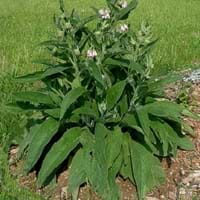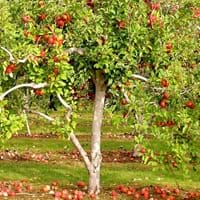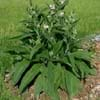Life Span
Perennial
Perennial
Type
Broadleaf Evergreen
Flowering Plants, Fruits, Trees
Origin
Europe, Russia
Central Asia
Types
Symphytum officinale (common comfrey), Symphytum asperum (rough comfrey)
Aceymac apple, Bailey Sweet apple, Dabinett apple, Nehou apple
Habitat
Cold Regions, stream banks
Hillside
USDA Hardiness Zone
6-11
5-8
AHS Heat Zone
Not Available
9-1
Sunset Zone
21,22
A1, A2, A3, 8, 9, 10, 11, 12, 13, 14, 15, 16, 17, 18, 19, 20, 21, 22, 23, 24
Habit
Upright/Erect
Oval or Rounded
Flower Color
White, Light Pink
White
Flower Color Modifier
Bicolor
Not Available
Fruit Color
Not Available, Orange Red
Green, Red
Leaf Color in Spring
Red, Green, Copper
Dark Green
Leaf Color in Summer
Green, Blue Green
Green
Leaf Color in Fall
Green, Blue Green
Brown, Green, Light Yellow
Leaf Color in Winter
Red, Dark Green, Burgundy, Bronze
Not Available
Plant Season
Spring, Summer, Fall, Winter
Spring
Sunlight
Full Sun, Partial Sun, Partial shade
Full Sun, Partial shade
Growth Rate
Medium
Medium
Type of Soil
Loam, Sand
Loamy
The pH of Soil
Acidic, Neutral
Neutral
Soil Drainage
Well drained
Well drained
Bloom Time
Late Spring, Early Summer, Summer
Fall, Summer
Tolerances
Not Available
Drought
Where to Plant?
Container, Ground
Ground
How to Plant?
Root Division, Transplanting
Grafting, Seedlings, Transplanting
Plant Maintenance
Low
Medium
Watering Requirements
Allow to dry out slightly between watering, Water daily during growing season
Medium
In Summer
Lots of watering
Lots of watering
In Spring
Moderate
Moderate
In Winter
Average Water
Average Water
Soil pH
Acidic, Neutral
Neutral
Soil Type
Loam, Sand
Loamy
Soil Drainage Capacity
Well drained
Well drained
Sun Exposure
Full Sun, Partial Sun, Partial shade
Full Sun, Partial shade
Pruning
Cut or pinch the stems, Remove dead leaves
Prune when plant is dormant, Remove dead or diseased plant parts
Fertilizers
14-14-14 Fertilizer, All-Purpose Liquid Fertilizer, can go long without fertilizers
All-Purpose Liquid Fertilizer
Pests and Diseases
Aphids, Stem spot
Aphids, Canker, Caterpillars, Powdery mildew, Root rot
Plant Tolerance
Shallow soil, Sun
Drought
Flower Petal Number
Single
Single
Foliage Texture
Medium
Medium
Foliage Sheen
Glossy
Matte
Attracts
Ants, Butterflies, pollinators
Birds
Allergy
Antibacterial, Peripheral Edema
Mouth itching, Throat itching
Aesthetic Uses
Cottage Garden, Showy Purposes
Not Available
Beauty Benefits
Acne, Beautiful Skin, Reduce Bruises, Remove blemishes
Not Available
Environmental Uses
Air purification, Fixes Nitrogen
Air purification
Medicinal Uses
Asthma, Diarrhea, Obesity, Osteoarthritis
Cancer, constipation, Diabetes, Diarrhea, Dysentry, Fever, Heart problems, Tooth ache
Part of Plant Used
Leaves, Twigs
Fruits
Other Uses
Used for its medicinal properties
Used As Food, Wood is used for making furniture
Used As Indoor Plant
No
No
Used As Outdoor Plant
Yes
Yes
Garden Design
Container, Feature Plant, Foundation, Groundcover, Hedges, Mixed Border, Tropical
Fruit / Fruit Tree, Shade Trees, Showy Tree
Botanical Name
Symphytum asperum
Malus domestica
Common Name
Comfrey,Black Root, Blackwort, Bruisewort
Apple Tree
In Hindi
Blackwort
सेब का वृक्ष
In German
Blackwort
Apfelbaum
In French
Blackwort
Pommier
In Spanish
Blackwort
Manzano
In Portuguese
Blackwort
Macieira
In Polish
Blackwort
jabłoń
In Latin
Blackwort
Arbore
Phylum
Magnoliophyta
Magnoliophyta
Class
Magnoliopsida
Magnoliopsida
Family
Boraginaceae
Rosaceae
Clade
Angiosperms, Eudicots, Rosids
Angiosperms, Eudicots, Rosids
Tribe
Not Available
Not Available
Subfamily
Boraginoideae
Not Available
Number of Species
Not Available
Not Available
Season and Care of Comfrey and Apple Tree
Season and care of Comfrey and Apple Tree is important to know. While considering everything about Comfrey and Apple Tree Care, growing season is an essential factor. Comfrey season is Spring, Summer, Fall and Winter and Apple Tree season is Spring, Summer, Fall and Winter. The type of soil for Comfrey is Loam, Sand and for Apple Tree is Loamy while the PH of soil for Comfrey is Acidic, Neutral and for Apple Tree is Neutral.
Comfrey and Apple Tree Physical Information
Comfrey and Apple Tree physical information is very important for comparison. Comfrey height is 20.00 cm and width 90.00 cm whereas Apple Tree height is 25.00 cm and width 20.00 cm. The color specification of Comfrey and Apple Tree are as follows:
Comfrey flower color: White and Light Pink
Comfrey leaf color: Red, Green and Copper
Apple Tree flower color: White
- Apple Tree leaf color: Dark Green
Care of Comfrey and Apple Tree
Care of Comfrey and Apple Tree include pruning, fertilizers, watering etc. Comfrey pruning is done Cut or pinch the stems and Remove dead leaves and Apple Tree pruning is done Prune when plant is dormant and Remove dead or diseased plant parts. In summer Comfrey needs Lots of watering and in winter, it needs Average Water. Whereas, in summer Apple Tree needs Lots of watering and in winter, it needs Average Water.





